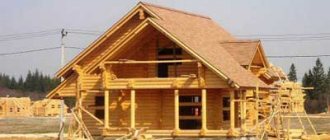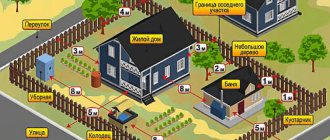Pravozhil.com > Real estate registration > Land registration > What can be built on individual housing construction lands - residential, household and commercial buildings
Land plots classified as individual housing construction are plots intended for individual construction with a specific purpose. Therefore, those who want to purchase such a plot for commercial or personal purposes should find out in advance what can be built on individual housing construction lands and what is strictly prohibited by law.
How to obtain a building permit on a private housing construction site?
In accordance with the regulations of the Federal legislation (Federal Law No. 190 of December 29, 2004), every Russian citizen who owns a plot of land classified as individual housing construction must obtain the appropriate permit before starting construction.
The consent of the authorized bodies will also be required to carry out reconstruction, modernization, redevelopment, or completion of a house intended for single-family residence.
To carry out all construction and installation activities, it will be necessary to prepare and approve project documentation.
Important! The owner of a land plot can begin construction or reconstruction of a residential property only after receiving a permit from the architectural authority and the district administration.
To do this, he needs to collect a large number of certificates, certificates and other papers. You will also have to pay a fee and incur costs associated with the procedure.
A construction permit is a document that indicates that the project in the hands of the owner of the land plot fully complies with all norms and standards.
The permit also confirms the compliance of the design documentation with the requirements of the urban development plan approved at the legislative level.
Having such a document in hand, the owner of a plot of individual housing construction land can begin individual construction, major repairs, reconstruction and redevelopment.
To obtain a construction permit, an individual must collect the following documents:
- Application from the developer.
- Cadastral passport.
- Certificate of ownership.
- Land lease agreement if the development will not be carried out by the owner.
- Urban planning plan of the allotment.
- Design documentation approved by the architect.
- Written consent of all owners of a residential building if it is planned to carry out its reconstruction, redevelopment and major repairs.
- Civil passport of the owner of the plot - an individual developer.
- Tax identification number.
Important! In accordance with the regulations of Gr. Code of the Russian Federation, authorities cannot request other documents from the developer of a land plot classified as individual housing construction.
After an individual submits a package of documents to the local administration, a permit to build a residential property will be issued to him within 10 days.
During this time, employees of the government agency will check all submitted certificates and project documentation. If they do not have any questions or complaints, the applicant will receive permission and will be able to immediately begin construction and installation work.
The document is valid for 10 years, after which you will have to obtain permission again if the facility has not yet been put into operation.
If the local administration refuses to issue a certificate, the individual has the legal right to involve representatives of Themis in resolving the issue. He needs to draw up a statement of claim and submit it to the court located at the location of the land plot.
If you have already built a house on a summer cottage, how to decorate it
If you built a house on your summer cottage without obtaining permission, then you have no legal grounds to consider it your property. Only after you have registered your right of ownership with the appropriate service and your country house has been assigned a cadastral number, you will be able to perform various actions with it: sell, exchange, donate, inherit, insure and use as collateral.
In 2006, legislators passed a law called the “dacha amnesty.” Unauthorized developers of summer cottages now have the opportunity to register ownership of unregistered real estate using a simplified version. The latest changes introduced by Federal Law No. 36-FZ of February 28, 2018, allow you to take advantage of the simplified registration procedure until December 31, 2020.
However, the simplified procedure for registering land plots and real estate, in force before these amendments, ended on March 1, 2019. The new procedure requires more documents, and registration of rights now takes place through a notification procedure.
Also, the simplified procedure has been expanded for those citizens who have unregistered real estate and land plots received before the date of entry into force of the Land Code of the Russian Federation - October 1, 2001.
The law on “dacha amnesty” until 2021 expands the required package of documents. Now, to successfully register real estate, you will need:
- application for registration of ownership;
- a document confirming the right of ownership of the property (a document on the possibility of indefinite use of land, a purchase and sale agreement, a certificate of inheritance);
- house plan, for which you should contact the Bureau of Technical Inventory. A cadastral engineer will come to your site to take the necessary measurements. Then, within 10 working days you will be given the relevant documents. The cost of this service ranges from 7,000 to 15,000 rubles;
- receipt of payment of state duty in the amount of 350 rubles.
To submit documents you can currently use:
- official website of Rosreestr;
- email;
- Multifunctional center (MFC);
- Russian Post.
There are restrictions when registering real estate in garden non-profit partnerships (SNT), dacha non-profit partnerships (DNP):
- the building can have no more than 3 floors;
- the height of the house must be less than or equal to 20 meters;
- the distance from the building to the boundaries of the site should not be less than 3 meters.
If you have not completed all the paperwork for your property in advance, you will have to obtain permission in order to have the right to use the house. You will need to prepare a list of documents:
- land and house plans;
- design documentation;
- engineering communications diagrams;
- documents confirming the construction’s compliance with technical standards.
What can be built on individual housing construction land plots?
On land plots allocated for individual construction of residential real estate, it is possible to build low-rise buildings, as well as outbuildings for personal use:
- greenhouses;
- sheds;
- baths;
- garages;
- gazebos.
Legislation also allows for the establishment of gardens, vegetable gardens and flower beds on private lands. If an individual owns a land plot of individual housing construction, he can engage in personal subsidiary farming.
For example, raise poultry, pigs, goats, cows and install beehives. After the developer completes the construction of a residential building on his site, he can sell it along with the land.
In accordance with the regulations of Federal legislation, regional authorities must develop infrastructure at the locations of individual housing construction plots. Local residents have the right to demand the construction of retail outlets, hospitals, quality roads, post and bank offices, and public transport stops.
House
When carrying out construction and installation work on the construction of a residential building, the following standards must be observed:
- no more than three floors;
- area up to 1500 m2;
- construction sites should not be close to the red line;
- to the neighboring household from 15 m (wooden houses). From 6 m to the border with neighbors - stone houses;
- ceiling height from 2.5 m;
- bedroom from 8 m2;
- living room from 12 m2;
- bathroom from 2.7 m2;
- the height of the fence with neighbors is from 1.5 m, with the street from 2.5 m;
- electrical wiring in a protective sheath;
- gas containers should be stored outside the home;
- auxiliary buildings at a distance of 4 m from a residential building.
Garage
The process of constructing a garage requires compliance with the sanitary legislation of the Russian Federation:
- the gate faces the street - there should be no obstacles for pedestrians.
- to the wall of a neighboring house - from 6 m;
- to the road from the garage - at least 3 m;
- to the fence from the garage - from 1 m;
- to the residential building of the owner of the site - at least 3 m.
Bath
Types of individual housing construction
When constructing baths and saunas on personal plots, owners must comply with the norms of legislation in force in the Russian Federation. They also cannot violate the established rules:
- The bathhouse should be located at a distance of 5 m from a residential building.
- The building can be erected at a distance of 3 m from the neighboring plot.
- If the area constantly receives heavy rainfall, the bathhouse should be located on a hill.
- If the sauna is located close to a well with drinking water and a natural reservoir, a distance of 20 m must be maintained.
- All structural elements must be treated with fireproofing solution.
Greenhouse and greenhouse
On individual housing construction land plots, legislation allows the construction of buildings for growing vegetables and berries. Greenhouses and greenhouses can be placed at a distance of 1 m from a neighboring household.
Well
Before drilling a well, the owner of the individual housing construction site must conduct geological surveys. After this, calculations are performed and recorded in the database of the relevant department.
The land owner will have to obtain permission from Rospotrebnadzor. When starting to drill a well, the owner must comply with the following standards:
- to the septic tank at least 25 m;
- availability of a development plan;
- there is no roadway nearby;
- green spaces are located at a distance of at least 10 m;
- residential buildings should be located at a distance of 5 m.
EXAMPLES FROM JUDICIAL PRACTICE
In the Appeal ruling of the Rostov Regional Court dated August 17, 2015 No. 33-12490/2015, the court indicated that the authorized body unlawfully refused to issue a permit to the applicant without specifying as a reason any reason provided for by the Town Planning Code of the Russian Federation.
But when challenging decisions of an authorized body, it is important to check that the package of documents contains all the necessary documents. Otherwise, the refusal will be considered lawful. Thus, in the Appeal ruling of the Samara Regional Court dated December 26, 2014 No. 33-13008/2014, the court refused to satisfy the plaintiffs’ demands to challenge the refusal of the head of the city district to issue the plaintiffs permission to complete the construction of an administrative building. As the court indicated, in Part 7 of Art. 51 of the Civil Code of the Russian Federation establishes that for the purpose of construction, the developer sends an application for a construction permit to the body authorized to issue such permits with the attachment of documents, an exhaustive list of which is determined by this part of the article. In violation of the above rule of law, the package of documents presented by the plaintiffs did not contain the materials contained in the project documentation, as well as the positive conclusion of the examination of the design documentation of the capital construction project.
GOOD TO KNOW
If you run a business on your property, you must automatically pay land tax according to the same rules as organizations.
How can an entrepreneur pay land tax if he uses his land for business?
Unfortunately, often, along with a change in the permitted use of a land plot, the tax rate also changes.
According to Art. 394 of the Tax Code of the Russian Federation, tax rates are established by regulatory legal acts of representative bodies of municipalities (laws of federal cities of Moscow, St. Petersburg and Sevastopol) and cannot exceed, in particular, 0.3% in relation to land plots classified as agricultural lands or lands within agricultural use zones in populated areas and used for agricultural production, and 1.5% in relation to other land plots. Moreover, if tax rates are not determined by regulatory legal acts of representative bodies of municipalities (laws of federal cities of Moscow, St. Petersburg and Sevastopol), taxation is carried out at the tax rates specified in paragraph 1 of Art. 394 Tax Code of the Russian Federation.
But let’s imagine a situation where a company owned agricultural land. At the same time, for business purposes, the company built a logistics center on these lands. In this case, you will have to calculate the tax at an increased rate (letter of the Ministry of Finance of the Russian Federation dated December 10, 2014 No. 03-05-06-02/63414).
GOOD TO KNOW
In a situation where you have demarcated your land and divided it into two separate plots, you need to pay tax according to the rules described above for the one that you will use for business. But for land occupied by residential buildings, inspectors will continue to send you tax notices.
If land plots are not used for agricultural production, an increased tax rate is applied to calculate land tax in an amount not exceeding 1.5% of the cadastral value of the land plot.
Thus, in case of inappropriate use of land plots classified as agricultural lands or lands within agricultural use zones in populated areas, the tax rate may increase 5 times.
IMPORTANT IN WORK
A land plot from agricultural lands can be forcibly seized from its owner in court if, for three or more consecutive years from the date such an owner acquired the right of ownership of the land plot, it is not used for agricultural production or other related activities. agricultural production activities.
What can be built without permission?
If an individual does not have a permit to carry out construction and installation work, then he can erect outbuildings on his site. All objects that belong to the housing stock require appropriate permission.
In the event that the owner violated the requirements of Federal legislation and built a house in which the number of floors exceeds the permissible standards, or the building is designed to accommodate several families, he will be held administratively liable.
The first problems will arise when trying to register the building. The government agencies that control such issues may decide to demolish the building if the commission confirms that it does not comply with the individual construction project.
Also, financial sanctions are usually applied to violators, the amount of which is often unaffordable for ordinary citizens. To minimize all risks, individuals must comply with laws and act in accordance with approved procedures.
Every citizen who purchases a plot of land should find out that it is possible to build individual housing construction on land plots. He has the right to count on connection to all utilities if centralized highways are laid in the immediate vicinity.
In practice, it often happens that country residents provide themselves with water on their own by drilling wells in the ground. Also, in some areas it is not possible to connect to the centralized gas supply system. In this case, owners of private houses install electric or solid fuel boilers.
Is it possible to build an apartment building on individual housing construction lands:
See also Phone numbers for consultation Jan 25, 2021 kasjanenko 1741
Share this post
Discussion: 3 comments
- Olya says:
03/06/2019 at 03:06As I understand it, anything can be built on such sites. But before construction, as I understand it, it will be necessary to obtain permission, but I really don’t know where to get it. Could you tell?
Answer
- Rita says:
05/21/2020 at 00:52
We built a store on such a site. But before that, we spent several months running around the authorities to get the paper with permission in our hands. Everything seems simple, but in reality it’s red tape
Answer
- Lola says:
05/22/2020 at 00:16
After many months of running around in offices, we received individual housing construction land for use. In the clarifying documents, we indicated that we were planning to build a store. Now we feel confident with the documents
Answer
How to create a digital business in individual housing construction, increasing the quality of suburban development
Hello, Habr! My name is Samuel and I am not an engineer or an IT specialist, but an entrepreneur. As an entrepreneur, I look at any thing through the prism of how it can be improved and build a business on it. This is a hobby for me, I write down all ideas in notes, and analyze some in more detail, for example, building a financial model.
Most often, ideas arise when I am faced with a problem that is difficult to solve. The idea that we are going to talk about is no exception - my family and I built our own house and experienced the difficulties of construction ourselves. At the same time, the idea that I will talk about can be implemented by a developer who does not understand construction - no special knowledge is required.
Let me note right away: there are many problems in individual housing construction, but now I will tell you only about one of them, because I am sure that its solution will improve the quality of suburban development and will help many people. Once you dive into the topic, you will probably find many other interesting ideas.
The essence of the problem
In Russia, a huge number of individual residential buildings are built without design documentation - many land owners, at best, have an architectural project (layout diagram and facade design). The law allows this, see Part 3 of Art. 48 of the Town Planning Code of the Russian Federation:
"3. The preparation of design documentation is not required during the construction or reconstruction of an individual housing construction project or a garden house. The developer, on his own initiative, has the right to ensure the preparation of design documentation in relation to an individual housing construction project, a garden house.
3.1. The provisions of Part 3 of this article do not apply if the estimated cost of construction, reconstruction, major repairs of an individual housing construction project is subject to verification for the reliability of its determination.”
When we built the house (I write more about this epic on my Instagram), we did not provide any documents other than cadastral documents when notifying the start and completion of construction - but this measure is aimed only at preventing unauthorized development, for cadastral registration and registration of the house in own. The cadastral documents do not contain projects with technological calculations that take into account the characteristics of materials and soil.
People decide to do without project documentation because:
- Many foremen and builders willingly take on projects without documentation. Customers trust their opinion and experience, so they see no point in developing a project. At the same time, they can refuse all types of projects: engineering, where calculations are made taking into account the characteristics of materials, projects for water supply, heating, electricity, lighting.
- The development of project documentation takes a lot of time, and for those who are building a house, the opportunity to move to a new home as soon as possible is often important. In addition, there are seasonal restrictions: building in winter is expensive and risky, so if people bought a plot in the spring, or even more so in the summer, they need to finish at least the box by winter.
- Ordering design documentation is expensive, especially if you are planning a spacious two-story house. The average price is from 300–400 rubles. per sq. m. (and this is only for one project - and calculations are needed for heating, water supply, etc.).
- There is a widespread opinion that project documentation is “for commercial real estate”; it is “not needed, because even the legislation allows not to do it.”
But abandoning design documentation is dangerous. There are three main scenarios:
- There will be conscientious builders who will not want to take risks and will use materials in reserve: they will choose stronger reinforcement and a higher grade of concrete, make thicker floors, etc. This will increase the costs of the project. It seems that such reinsurance will compensate for the abandonment of engineering projects. But this is not always the case, because materials have different properties: for example, if the thickness (and therefore the mass) of the ceiling is greater than necessary, it may crack or collapse.
- Builders will do it “by eye”; due to an ill-conceived project, the usable area will be reduced, operating costs will increase, and problems will arise (for example, the walls in the rooms will freeze). Due to incorrect calculations, the electricity supply will cause traffic jams, and the water supply and heating will also not be in order. Repairs and error correction will require additional costs.
- In the worst case, it will be impossible to live in the house - the roof is leaking, the walls are cracking, etc. Due to errors in calculating the power supply, the wiring cannot withstand it, and a fire may start. You will have to spend a large sum to correct errors.
In this video (I have already rewound to the right place) Anton Vasiliev, a mechanical engineer, discusses the essence of this problem of individual housing construction.
Market size
Interest in custom construction is growing. The “Program for the Development of Individual Housing Construction in the Russian Federation” contains the following figures:
“Every year in Russia, according to Rosstat, the population builds 250–270 thousand individual residential buildings with a total area of 30–36 million square meters at their own expense. m. (40–45% of the total commissioned housing area). The average house area is 140 square meters. m."
This program was developed at the direction of Vladimir Putin: according to his instructions, by 2024 the annual volume of individual housing commissioning should exceed 40 million square meters. m. Now the demand for organized individual housing construction is in full swing, it is planned to create a new financial instrument that will simplify mortgage lending for individual housing construction and make it more reliable and convenient for citizens. The market size is already large (detailed data here), but it will certainly continue to grow.
This means that more and more people will be faced with a choice: to order design documentation or not, and if not to order, then how to achieve high quality construction.
How do they now solve the problem of construction without design documentation?
There are several options.
The first is to completely trust the builders and hope that they will do everything right.
The second is to delve into the matter yourself, to fully control the construction. From experience I can say that this is extremely difficult, almost impossible - it takes an incredibly long time to even understand the materials and technologies on the market, where everyone praises exactly those solutions that he likes. In fact, in a few weeks or months you need to take from somewhere the experience and knowledge that specialists have been accumulating for years. It’s unlikely to be possible to combine immersion in a project and full quality control of construction with work.
The third is to apply for a technical supervision service (usually provided by companies). An independent specialist comes, checks the quality of the work, gives recommendations on materials, etc. The problem is that you have to pay for each visit (on average, from 5 thousand rubles), and important decisions at a construction site need to be made multiple times. As a result, construction costs seriously increase - against the backdrop of rising prices for building materials, this makes your own home very expensive.
Fourth, look for individual specialists for consultations. I was lucky in this matter: one of my friends is a civil engineer. But many people are not so lucky: they have to look for specialists in different fields themselves and choose those they can trust.
Fifth, choose a standard project. This has its own difficulties: you need to take into account the climate, soil characteristics, etc., in addition, you will have to look for a ready-made solution that will suit future residents, and sometimes this is very difficult to do. But you can get a project at much lower costs.
Additional challenges: repairs and bug fixes
Mistakes made during construction may appear after the work is completed: for example, in winter, when it turns out that the heating system is not coping with the task, or in spring, when the garage and basement begin to flood. Shrinkage can lead to cracks in the walls, and the roof may not be able to support the weight of the snow. So people who saved on design documentation and/or made a mistake when choosing builders sometimes need urgent advice from a specialist. They need to know how to solve the problem quickly.
Both in this situation and with the general deterioration of structures, major repairs may be necessary - and this again means calculations, planning and the search for skilled craftsmen.
Hardcore calculations to strengthen the emergency ceiling
See how this happens in a real example.
The bottom line: the builders made an emergency reinforced concrete floor slab, but it began to crack and sag. The main motive of the builders is economy, due to which there is no upper reinforcement belt in the slab.
In some cases, this error can be corrected by additional strengthening of the structure. But then you need to calculate and evaluate the rationality of each option from a financial point of view. It might be cheaper to dismantle and rebuild.
This case clearly demonstrates that if the project is individual, you will have to contact an engineer for calculations before or after. Errors do not always appear immediately, but they will definitely make themselves felt. It is more logical to order design documentation before starting work than to trust foremen and builders. Read more about this story on the Stroykhlam channel.
It’s one thing when the reserve is calculated by engineers and serves as insurance in the model. And it’s quite another thing when construction teams blindly lay materials in excess (as I said, this can have a bad effect on the quality of construction, not to mention an unjustified increase in price).
How can you solve a problem using IT?
Reduce the cost of technical supervision and engineering calculations - then people will be more inclined to use the services of specialists, and this will reduce the risk of technical violations.
The idea is remote services for engineering calculations and technical supervision, a platform for private construction or repair. Clients can connect to the service, send videos, photos, make video calls, order the necessary calculations online, etc. If I were building such a business, I would focus on saving materials by reducing overruns. This is profitable, safe, and environmentally friendly - a good basis for a strong positioning in the modern market.
An important nuance: in some cases, you cannot do without a visit - for example, if you need to measure heat loss. In this case, through the service, the customer can arrange for an engineer to visit the site (of course, for an additional fee). This means that the service should include geolocation or at least the ability to manually indicate the location of the customer’s facility and the locality where the engineer lives. But, in my opinion, the service needs to be positioned as an option for preventing errors - so that people start with calculations and only then move on to construction. In short, emphasis on prevention.
Pros of the solution:
- Costs for engineering calculations will be reduced. People will be more inclined to include this service in their budget. This means that construction costs will be reduced: the foreman will not store building materials with a reserve “by eye”, taking into account the high price of materials, this will help achieve significant savings. The house will cost less, but will be safe and reliable.
- The cost of technical supervision will be reduced (and therefore the price for the client), since the specialist will not have to go to the site every time.
- Specialists will be able to fulfill much more orders than when working offline.
- Clients will have the opportunity to quickly get advice - there are a lot of urgent issues at a construction site, so this is very convenient.
- Clients and specialists are not limited by geography. The former get access to experienced craftsmen from different cities, the latter can count on a larger number of orders, even if they currently live in a small town or village.
- The client can quickly request a second or even third opinion to make an informed decision.
- The client can receive advice from specialists of a narrow profile without contacting a company that offers a range of services. Firstly, it's cheaper. Secondly, you can hear the opinions of different professionals who do not work for the same organization, which means that one specialist can point out the mistakes of another without fear that this will damage the reputation of their common employer.
- Not only people who build a house can become clients: the engineer’s advice will also come in handy during major renovations. In addition, after construction is completed, defects may appear that will have to be corrected (cracks in the walls, problems with wiring, etc.).
- Using the service, you can solve problems in parts: first make calculations for the foundation, after a few months move on to building the box, etc. If people do not have the money to build a house right away, they stretch out the construction for several years - in this case, a comprehensive service is simply not possible needed.
Hence the advantages of the project:
- affordable price for engineering services (much cheaper than ordering an on-site service);
- the ability to reduce construction costs;
- the ability to order calculations for specific devices, rather than an entire project;
- high speed of decision-making (if a site visit is not needed): contact, talk with a specialist, and the problem is solved, no need to set a meeting time, wait for an engineer to arrive, etc.;
- high quality of expertise - the number of specialists should include only those who have state accreditation.
Option for building business processes:
- Experts connected to the service receive a request similar to a taxi - when they are on the line. This will allow those engineers who have a main job to take on part-time work. And most importantly, this is how the second advantage (speed of decision-making) is realized.
- Experts receive piecework payment. Tests and calculation of a financial model will help you understand what the tariff should be. In my opinion, it is better to unify the tariff matrix.
- The client sends a request to the chatbot. The expert selected by the system is connected to the chat. At first, you can set up a simple solution, and later you can build an IT system with an interface for experts: for example, to automate the process of assigning and reassigning specialists, and to control communication.
- You also need to involve teams that work for themselves and agree to build without design documentation - for them the service can become an assistant. If a builder does not have enough knowledge or skills to perform certain work on a customer’s project, he will be able to turn to an expert for help. This way he won't let the client down. This is definitely better than doing it at random and making gross mistakes.
The big advantage is that you don’t have to immediately create a complex, expensive service. You can start small - for example, with a chatbot and several dozen experts. A project can be launched quickly and at relatively low cost, and then hypotheses can be tested, the experience gained taken into account, the service gradually expanded and complicated, and new services added.
It seems to me that a developer who wants to create such a project will cope with the task - for this he does not need to understand construction. You can start small - with remote technical supervision, then move on to the segment of custom-made calculations (for example, calculations for heating, water supply, etc.), and then involve the development of project documentation as a whole.
What do you think about this idea? Would you like to implement it? Or do you even have a more elegant solution to the problem? I hope for your responses - this is important to me. If I see that the topic is interesting, I will share other ideas.
More useful information about individual housing construction is on my Instagram. Information about new articles with business ideas will also appear there.










